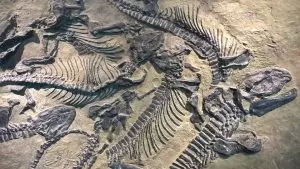“The persistence of original soft tissues in Mesozoic fossil bone is not explained by current chemical degradation models.”—Mary Higby Schweitzer, Proceedings of the Royal Society, 22 January 2014 Volume 281, issue 1775, “A role for iron and oxygen chemistry in preserving soft tissues, cells and molecules from deep time”
Here, in this tenth installment of our series, we continue to critique the book, “Dinosaur Blood and the Age of the Earth,” by Fazale Rana (better known as Fuz Rana), an old-earth creationist and a prominent member of the Reasons to Believe organization headed by Hugh Ross. This article continues our examination of Chapter 4, “How Did Soft Tissue Survive in Dinosaur Fossils?”–pages 53-72.
(Previous articles of this series can be found here: Part 1, Part 2, Part 3, Part 4, Part 5A, Part 5B, Part 5C, Part 6, Part 6B)
Mary Schweitzer, Mark Armitage and the Blood Iron Preservation Hypothesis

Atheist evolutionists and old earth creationists have been zealously promoting what they want everyone to believe is an explanation of how soft dinosaur tissue could endure over hundreds of millions of years. It is the “iron in the blood” speculation. Over the last five years or so, this proposal has become what could be called “the party line,” the default “explanation” for extant dinosaur tissue for those with faith in deep time. Fuz Rana summarizes this speculation thusly:
“[Mary] Schweitzer and her team noticed that iron particles have been found in close contact with soft tissue fragments in dinosaur fossils. This discovery serves as a telltale sign that iron has played a role in fixing and preserving the soft tissue remains in these fossils. To confirm that hemoglobin in dinosaur bone really does exert a protective effect, Schweitzer’s team soaked blood vessels isolated from ostrich bone in two different solutions: one containing hemoglobin and one consisting of pure water. After two years, the blood vessels in the hemoglobin bath remained intact, but the ones in water fell apart. So, it looks as if iron does indeed play a role in preserving soft tissues in dinosaur bones after they die.”—pg. 65
Pardon my cynicism…but really? Really? Based on this experiment? Mark Armitage has characterized Schweitzer’s experiment as a “tenth grade science experiment.”
Water is, after all, known as “the universal solvent,” so is there any surprise that something soaked in water would “fall apart” after two years? Remove water from the equation and many things will persist longer than normal—perhaps as long as thousands of years. Most of us, I think, are aware that the dry desert of Egypt has helped preserve mummies and other relics of the past for thousands of years. But the process of decay, though slower, continues nevertheless.
Thousands of years is by no stretch of the imagination the same thing as millions.
So, Dr. Rana actually wants us to believe that soft dinosaur tissue presumed to be 68 million years old (to say nothing of presumed half a billion year old sub-Cambrian beard worms and animal cholesterol) persisted over eons of time? Dr. Rana (and Mary Schweitzer, et al) is going to have to do much, much better than that. Schweitzer’s experiment barely rises to the bar of bare speculation. I am frankly incredulous that a scientist with Mary Schweitzer’s training and a biochemist with Fuz Rana’s knowledge would promote this to the general public as “the answer” to how dinosaur tissue has endured to the present.
Microscopist, Mark Armitage, is incredulous, as well. (See his videos: Iron 1, Iron 1B, and Iron 2)
Mark Armitage has critiqued both Mary Schweitzer’s experiment and Fuz Rana’s commentary on it. Armitage notes:
“Forensic pathologists have had a lot of years to study the behavior of blood in a dead body or in a limb, a severed limb…this information is well-established and well known among scientists. There is an established science in forensics that can predictably say…how the blood is going to behave in a dead body or a severed limb.This is predictable.”—(see video at approx 11:50)
Armitage points out that the first two hurdles in Schweitzer’s hypothesis is the natural pooling and then clotting process of blood. Blood in a dead body or a severed limb first pools to the lowest point and then clots. The clotting process would prevent the blood (or, more precisely, the iron content of the blood) from having even an opportunity to serve as a chemical cross-linking agent, a fixative, a preserving agent, as is proposed in the blood iron preservation hypothesis.
Schweitzer’s Missing Materials and Methods Section

Armitage goes on to point out something very interesting to me personally, namely, that Schweitzer’s Materials & Methods section is not part of her published paper. Armitage points out that this is unusual (see video at approx 11:44).This raises questions in my mind. Is there significant information omitted from the published paper? Scientific papers, especially research papers, usually have the Materials & Methods section incorporated right into the paper so interested parties may evaluate the actual experiment itself. Why is Schweitzer’s missing from her published paper?
Armitage points out that Schweitzer’s Materials & Methods section is only available online to those with a subscription to Science or to those who are willing to pay for it. This certainly creates a significant obstacle to anyone wanting to critically evaluate Schweitzer’s experiment. Fortunately, Mark Armitage did access the Materials & Methods paper and he comments upon some significant aspects of Schweitzer’s methods.
First, Schweitzer applied anticoagulants to the blood to prevent the natural clotting process. This raises a red flag in my mind. What natural condition of the Hell Creek Formation in Montana where her Tyrannosaurus rex remains were found was Schweitzer trying to replicate by her use of anticoagulants?
Second, Schweitzer used high speed centrifuges to spin down the blood to separate its constituent parts and thwart all the natural chemistry that this involves. This raises yet another red flag in my mind. What natural conditions of the Hell Creek Formation was Schweitzer trying to replicate by spinning down the blood in high speed centrifuges?
Third, Schweitzer used molecular filters on the blood. This raises yet another red flag in my mind. What natural conditions of the Hell Creek Formation was Schweitzer trying to replicate by her use of molecular filters?
With all of this high-tech alteration of the blood, do we wind up with anything even remotely relevant to what happened in the ground at the Hell Creek Formation in Montana where Schweitzer’s dinosaur remains were found? I think not. In fact, it seems to me that all of Schweitzer’s methods represent an attempt to sidestep all of the natural factors that would have contributed to the normal decay process. Don’t we want to replicate the real-world conditions as closely as possible in order to understand what actually happened?
With all of this special manipulation of the blood, I would not doubt that Schweitzer essentially devised her own mummification formula that would help the remains persist for an additional thousands of years! Schweitzer’s experiment is a very, very long way from proving that unprocessed blood (or even processed blood) can preserve dinosaur tissue for millions of years. Yet Fuz Rana, Mary Schweitzer, et al, are asking us to believe that organic remains treated with high-tech processes and sitting in a laboratory for two years somehow correlates to dinosaur tissue persisting in the ground for 68 million years.
Really?
Armitage Answers
In her 2013 paper, Schweitzer presents photographs of the dinosaur tissue from the Hell Creek Formation. (See figure C from Schweitzer’s paper at about 21:41 in Armitage’s video, and Figure E of a supposedly “Amorphous layer” at approximately 24:54.) Schweitzer’s main speculation in her paper is that the tissue samples she analyzes were preserved by “iron infiltration.” Significantly, there is no iron in the “amorphous” layer.
Armitage points out that what is actually seen in Figure C is not infiltration but pooling of the iron filaments into a distinct, segregated layer and that the iron is highly localized on one side of the blood vessel. How does the layer of iron demonstrate infiltration? Isn’t this exactly the opposite of Schweitzer’s characterization? Schweitzer’s characterization of the iron as “infiltration” contradicts the actual visible evidence. Armitage points out that this looks like the natural pooling process of blood after death.
Secondly, in Figure E of Schweitzer’s Materials & Methods, Schweitzer has labeled one area of the tissue as an “amorphous layer.” There are two significant things about this “amorphous” layer: 1) it is not amorphous but has a lot of structure including, apparently, organelles and 2) more importantly, there is no iron in this layer, yet it is also preserved. How does Schweitzer (and Fuz Rana) account for the preservation of the iron-less “amorphous” layer over 68 million years? Isn’t her argument (and Fuz Rana’s argument) based upon the idea of chemical (i.e., iron) “cross linking,” i.e., what is termed “fixation,” to perform this miracle of preservation?
It seems to me that Schweitzer’s analysis has been weighed in the balances and found wanting. The factual data is apparently mischaracterized by Schweitzer with subjective expectations superimposed upon the data.
How Real Science is Done
When attempting to determine processes that occur in the natural world, it is a common sense rule to try to replicate the conditions as closely as possible. Here is an example of a scientific investigation that did follow this common sense rule, that of Dr. Alan Feduccia, in his article, “Do Feathered Dinosaurs Exist? Testing the Hypothesis on Neontological and Paleontological Evidence,” from Journal of Morphology, 266:125–166 (2005). (See especially pages 128-131 of Feduccia’s paper.)
Note what Feduccia did: Feduccia took the study and examination of the carcass of a dolphin after it was buried in the ground for a year to ascertain the state of the collagen after actual decomposition. Now that is replication, as much as is possible, of the actual burial conditions of fossils. That is a sensible scientific experiment.
Notice also that in Feduccia’s paper his Materials and Methods is incorporated right into his paper for everyone’s evaluation. This is the normal procedure. Feduccia did not hide his M&M in a separate hard-to-access or obtain location.
It seems to me that all that Schweitzer’s experiment proves is that if you alter the remains by applying high-tech methods to separate and isolate the constituent parts, you may get something in the lab that will last for two years. Let’s say thousands of years speculatively.Two years or thousands of years is hardly the same thing as 571 million years!
A Key Paradigm Overthrown…But Which One?
Rana states:
“When Mary Schweitzer first published her reports of soft tissue remnants recovered from dinosaur remains, her results…caused an upheaval of a key paradigm in biology…
“As Schweitzer points out, ‘Our findings challenged everything scientists thought they knew about the breakdown of cells and molecules.’ They also indicate that the way paleontologists think fossilization takes place may be wrong.” Pg. 24-25

Note well: Schweitzer, Rana, et al, are willing to re-think “everything scientists thought they knew” about decay of cells and molecules, and they are willing to re-think “everything scientists thought they knew” about the fossilization process, but they are simply unwilling to re-think anything scientists think they know about their deep time paradigm. Why is that?
Why is deep time not open for reconsideration? If scientists have had everything wrong about tissue degradation and/or the fossilization process for the last 100 years or more, then why should we have any confidence in what (some) scientists believe about the age of the earth? Is it not possible that everything scientists think they know about the age of the earth is wrong also?
Deep time, unfortunately, gets a special exemption from being questioned. Deep time is simply a sacred cow that cannot be reconsidered no matter what. Their minds are simply closed to the possibility that it is their time paradigm that needs re-thinking. The irony here is that cell degradation information is based upon observable, empirical, repeatable science and the deep time advocates time paradigm is in the realm of historical reconstruction and is NOT based upon empirical data. So which represents more solid science?
Is Evolution Biblically Orthodox?

Schweitzer states in her paper:
“Biomolecules recovered from fossils have great potential to reveal aspects of the biology and environments of extinct organisms by: (i) independently testing and/or resolving evolutionary relationships determined by morphological characters; (ii) combining morphological and molecular data from both fossil and extant taxa to generate more robust phylogenies… (iv) providing, independently, estimates on rate and direction of molecular evolution.”– —Mary Higby Schweitzer, Proceedings of the Royal Society, 22 January 2014 Volume 281, issue 1775, “A role for iron and oxygen chemistry in preserving soft tissues, cells and molecules from deep time”—bold emphasis supplied
The real reason (many) scientists are not willing to question their deep time paradigm is not because the scientific evidence demands it but because such questioning upsets one of their most cherished articles of faith, the dogma of evolution. If there is no deep time, then evolution never happened. And we can have none of that, can we? No way, no how!
Whatever may be said about Mary Schweitzer’s faith as a professing Christian, no believer in evolution can, in my personal opinion, be characterized as an orthodox Christian. The word “orthodox” is a combination of two Latin terms, “ortho”–,meaning straight, and “dox”—meaning “word.” Orthodoxy is the straight word of Scripture.
Evolutionary speculations are blatantly contradictory to the biblical declaration of living creatures being created separately by God and reproducing after their own kinds. Evolutionary interpretations of biblical passages are not the straight word of Scripture but the twisted word. A person who believes in evolution and common ancestry of different kinds of living organisms must, of necessity, have a twisted and distorted view of biblical teachings. The doctrine of evolution is a distortion of biblical anthropology and a distortion of biblical zoology. More importantly, evolution also logically subverts the biblical doctrine of sin and redemption which is rooted in the creation narrative in Scripture.
Do not misunderstand me. Schweitzer is a competent and knowledgeable scientist. But so were the world’s leading scientists who were snookered by Charles Dawson’s Piltdown Man hoax, and Henry Fairfield Osborn’s Nebraska Man fraud. The Piltdown Man scientists “saw” in a human skull the unmistakable signs of an ape, and “saw” in an orangutan jaw the unmistakable signs of humanity. Likewise, Mary Schweitzer “saw” under her microscope “infiltration” of iron where there is apparently segregation, and she “saw” amorphous layers where there is apparently structure. Schweitzer is apparently the victim of what I have described as “the Piltdown Syndrome.”
Professional scientists are just as prone to subjectivism in their interpretation of data as are non-scientists. Perhaps even more so: the bestowal of professional degrees and titles carries with it the temptation to exalt one’s own preferences and biases above the empirical data while at the same time feeling that the professional accreditation somehow imbues one’s own word with infallible authority. This was clearly evident in the debates the Piltdown scientists had with one another over the analysis of the Piltdown Man skull. And it appears to me that Mary Schweitzer is a victim of subjective analysis (the Piltdown Syndrome) of the dinosaur tissue at her disposal.







